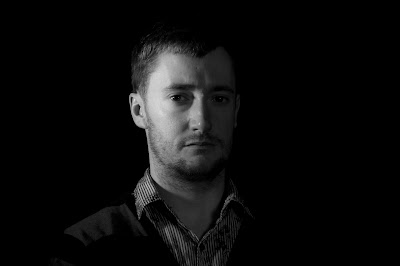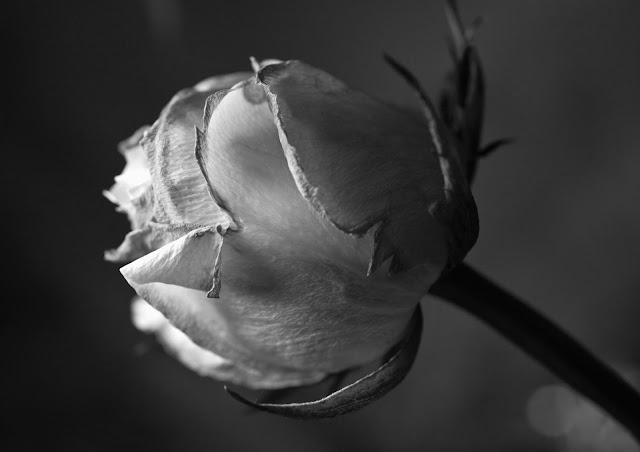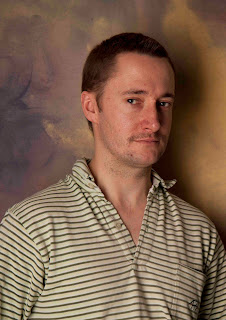Portrait
One of the tasks I was least looking forward to doing was the one piece of studio portrait we had to produce by independently assembling the set and lighting. Not because I was worried about setting up the studio or lighting but mainly because working with models was my least favourite activity. And my experience whilst trying to organise this has only reinforced my views about working with models.
I initially asked Sara from my class, whether she knew anyone who may be interested in doing some modelling for me. She gave me details of someone she knew who I contacted and arranged to come in the studio on a specific date. When I got into college the following week, I noticed my name had been crossed out from the studio diary and instead replaced with something along the lines of 'FdA priority' I presume it meant the degree students were using the studio. So I quickly cancelled my model and told her I would contact her soon to give her a different date. Later that day, Andrea my very generous classmate offered to let me use the studio for one of the mornings she had it booked, as she was busy doing something else that morning. I contacted the model but she wasn't available that day!! I desperately tried to get another model and luckily for me, Rukudzo, kindly helped me to recruit one via the wonders of Facebook. It was all set and ready to go until the night before the shoot when I decided to text my model to check everything was ok, when I'm told that her dad can no longer give her a lift! Not wanting to lose my model, I offer to pick her up in the morning. Little did I know what was to come next!!. On the morning of the shoot I get a text from her saying there's a problem with their boiler and she has to stay home and wait for work men! it's not really her fault and there wasn't a lot she could do about it, but it didn't help my situation!
I didn't want to waste my morning and the studio was already booked so I decided to pick my nephew and made my way in to college. I took quite a few photographs of my nephew, but like most children, his attention span wasn't great and I found it difficult to keep him still without him getting bored. When he did stay still he would freeze up a little and his expression did not look very natural. Perhaps if I had taken something in like a toy or something to entertain him then maybe I would have got him in a more relaxed state. However, it was all last minute and I didn't have much time to plan this shoot.
Initially the lighting set up included the black ground with the two black poly boards on either side. I didn't want any additional light spilling onto the subject from the sides or to create any unwanted shadows. I used a beauty dish, which is great for portraiture and to light up my nephews features and a softbox to soften the light a little.
The resulting image was ok, and this is the best one of the bunch as he's got a lovely expression on his face, good eye contact with the camera and a fairly relaxed pose. I think the image looks much better in black and white than colour but the problem here is that because he's got black hair it seems to have merged with the background. There's also a some shadows under his chin and I should have used the reflector to eliminate this.
I decided to change the light set up around to get a bit more light from behind his head so you could see the hairline. For this I used a snoot, which gives a sharp directional light. I also used a rectangular softbox to give a narrow band of light as I wanted to do a full length portrait.

This is the best image from that set up. I decided the full length portrait didn't look as good so I cropped this image to bring the attention to his face. I'm still not very happy with the image because a strong light has fallen to one side of his face and looks a little over exposed and there's still some shadow on the top of his nose. I could have used a smaller aperture to let in less light but then I may have under exposed the rest of the image. I also think he has a glazed look on his face, which doesn't reflect his personality very well or do justice to how he really is - lively, chatty, inquisitive and cheeky! he was quite bored by then and just wanted to go home! who can blame him? standing in front of the glare of the studio light for half a day!

Not entirely satisfied with my result I decided to book the studio for the following day and possibly use one of my fellow class mates to model for me. It was then I came across Roman, who made a bit of an impression on me. Piercing eyes, very strong jawline and well structured cheekbones, I immediately thought he had the perfect face for a strong portraiture.
I changed the studio lighting around a few times to see what sort of result I could achieve and practised on two willing victims (Andy and Sara!). I finally settled on a slightly low key set up with black background, black poly boards on either side, two soft boxes in front for a slightly high-key affect and a light with honeycomb from behind to illuminate one side of his face/hairline.
I quite like this image of Roman and it does look better in black in white than did in colour but just like my nephews photograph, it was difficult to separate his hairline from the background. Otherwise, I do feel it's a fairly strong portrait as the lighting works really well on his face. I used a new Black & White Adjustment Layer on Photoshop and then used Hard Light on the blending option to bring out his features.
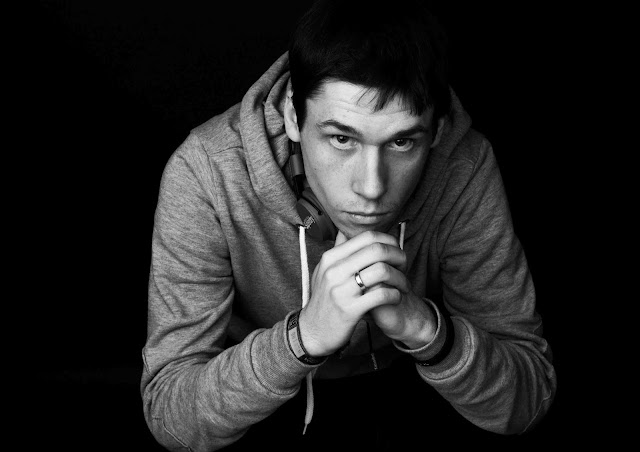
For my final submission I selected the following image. I feel it's a really powerful image and one that draws you in to look deeper into his eyes. It's by far the strongest portrait I have produced in the studio to date. I love the look in his eye, they look quite menacing and slightly intimidating - exactly the look I was aiming for. The light worked quite nicely as it highlighted one part of his face whilst the other side was slightly darker, adding to the moodiness his character. The cap on his head and the headphones around his neck gives the impression of a young trendy person, but with a slightly serious side to him. The image works really well because everything he's wearing contrasts very nicely with the dark black background, without blending in to it. To sharpen his features even further and to give him that slightly edgy look I turned the image to black and white and then used the Hard Light blending option. I feel this has given him a slightly rugged look, which compliments his features very well.

Still Life
I've always enjoyed photographing flowers. I think it's the colours, shapes, textures and variety that attracts me to them. I think someone once said if you can master photographing flowers then you can photograph anything! could have been John Kiely?! Flowers have been traditionally photographed to represent their soft, delicate and fragile quality. However, having been shown images from the tulip series by well known British photographer, John Blakemore, I wanted to try my hands at something different. Blakemore spent many years photographing still life, which included a series of images of tulips, where he would photograph them in natural light and particularly when they were past their best, typically a few weeks after their peak, capturing their gradual decline and natural elegance.
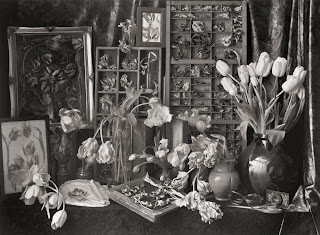 |
| http://www.lenscratch.com/2012/12/john-blakemore-at-klompching-gallery.html |
For my still life I decided do some experimenting at home with a bunch of flowers I had. I'd had them for a while so they were gradually wilting and withering away. I took the following images at night so I didn't have to worry about any light spillage from outside. I turned the main room light off and made sure there was no light coming in from any windows or doors. I then used the assistive light on my mobile to direct it towards the vase of white roses I had placed on the dining table. I wanted to highlight the decay of the roses and create a dark and moody atmosphere at the same time. I quite like the two images below but I personally think they are a little too busy which can look a bit distracting. I think the usage of a single light has worked quite well to create some nice shadows but overall the images are not strong enough to go in my final submission.

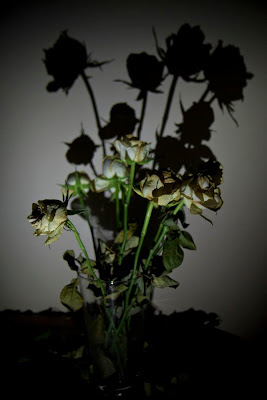
I decided to isolate one of the roses and focus on creating one strong single image. For this image I used just a table lamp which was pointing towards the rose. It was quite a strong light but I like how it has filtered through the whole rose, almost illuminating it from the inside. As it was night time photography and the lamp had a tungsten light, it had created a golden warm glow to the white rose. The textures on the petals show up very nicely, highlighting the beauty in its decay.
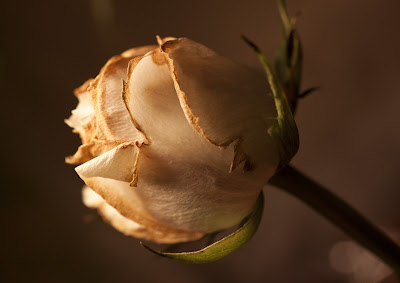
I feel the conversion to black and white and slight sharpening worked better with the rose and helped to bring out its characteristics and provide a nice contrast with the background. The viewers attention is now focused on the rose, with very little distraction. In conclusion I feel it's a fairly ok image but its not strong enough to be included in my final submission - to me it looks too ordinary and somehow lacks imagination!. However, due to time constraints I will make do with this for now, but I would like another attempt to produce something even better than this for my still life submission. For now, this'll have to do!



